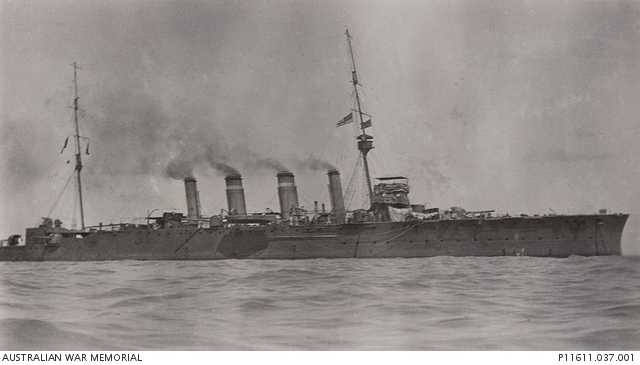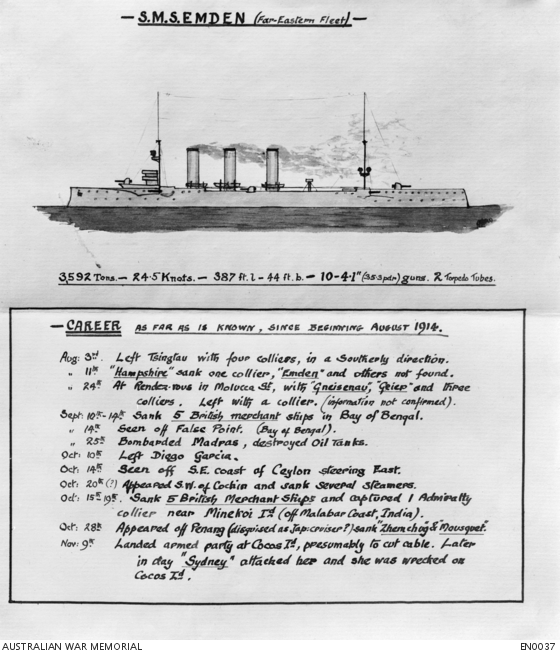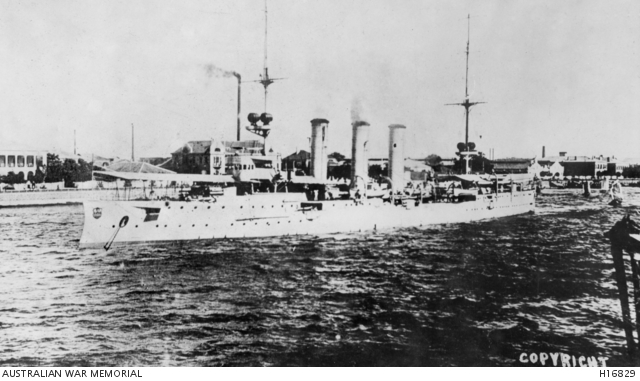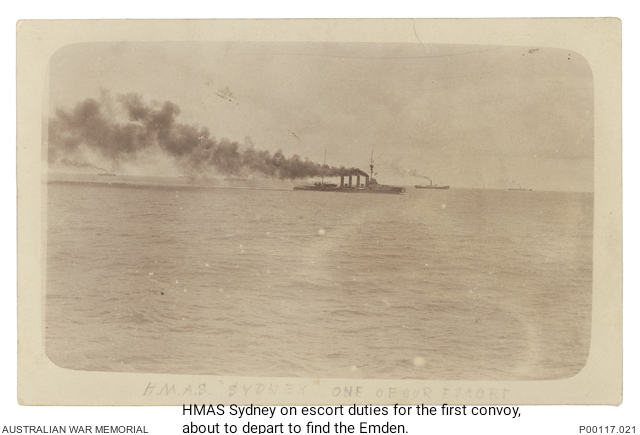Andy South has just completed volume II on his series detailing the career of the cruiser HMAS Sydney. He was kind enough to share an excerpt from his book. In this section, he examines the battle between HMAS Sydney and SMS Emden. If you would like to read the complete book, check out Andy’s works on Amazon.
H.M.A.S SYDNEY: A Chronological History Volume 2 August to December 1914
CHAPTER FIVE, SYDNEY v EMDEN, A COMPARISON.
As we arrive at the morning of the 9th November 1914,
we need to pause in the narrative and take a brief,
comparative look at the two opponents, HMAS Sydney
and SMS Emden*. They were both light cruisers and that
all too easily leads to the assumption they were evenly
matched and the Emden’s loss was in a large part due to
her standing start from a harbour anchorage, while the
Sydney was at full steam and at sea, allowing her to
dictate the course of the action. As we will see that is to
a large degree valid, but ship for ship, on even terms how
did the two light cruisers match up?
*HMS – His Majesty’s ship. SMS — Seiner Majestät Schiff
– literally, “His Majesty’s Ship” in German.
In full load displacement the Sydney weighed 5,400 tons
and the Emden 4,260 tons, giving Captain Glossop’s ship
a 1,140-ton (or 21%) weight advantage. The Emden was
338 feet 1 inch in length, 44 feet, 3 inches in the beam
and had a draught of 18 feet 2 inches. The heavier
Sydney was 456 feet 10 ⅜ inches in length, with a beam
of 49 feet 10 inches and a draught of 19 feet 7 inches. So in length alone the Sydney was 118 feet 1 inch (25.1%) longer and both beam and in the draught she was larger. Ship for ship the Australian vessel was considerably
bigger.
In performance the Emden could steam at 23.5 knots and
the Sydney at 25.7 knots, making the larger heavier
Sydney, 2.2 knots faster (2.53 mph) and gifting her the
ability to set both the tempo and distance of the
engagement. But her 2.2 knots are made even more
significant when it’s recalled that Emden started the
battle from a standing start and needed to build up a
head of steam to achieve her slower 23.5 knots. Plus,
after three months at sea and no record of having been
into dry dock since at least June 1914, her hull would
have accumulated marine growth and as a result her top
speed would not be the 23.5 knots, nor maybe not even
with in a knot or two of that. However, we know Sydney
had her hull scraped in October just before she departed
Sydney to join the convoy on the west coast. The speed
advantage was in the Australian court and from every
angle Korvettenkapitän * Müller was at a disadvantage.
*Korvettenkapitän Corvette captain is a rank in many
navies which theoretically corresponds to command of a
corvette. The equivalent rank in the UK, Commonwealth,
and USA is lieutenant commander.
But in the end the deciding factor was the weapons the
ships carried. The Emden’s main armament was
comprised of ten 4.1-inch (10.5 cm) SK L/40 guns mounted in single units within gun shields. Two of these guns were placed side by side
on the forecastle, while six were located amidships, three
to each beam. The final pair were placed side by side aft.
This gave the German ship a broadside of five weapons
with four firing forward and a further 4 aft. The Sydney
carried eight B[reech] L[oad] 6-inch (152 mm) Mk XI
single mounted guns within shields as well. Her guns
fired 5 on each beam and three both aft and forward.
The German weapon had a reported range of 13,300
yards (12,200 metres) at 30°, while the Australian guns
reached out to 18,000 yards (16,000 m) at 22.5°. The rate
of fire for the German weapon was 15 rounds per minute
with a good gun crew and the Australian weapon could
manage between 5 to 7 rounds per minute. The Emden’s
shells were between 35 and 38lbs and the Sydney 100lbs.
The Emden’s magazines were also heavily depleted
having shelled Madras and Penang, plus having fired a
number of shells to despatch her merchant ship victims.
Sadly, from a gunnery comparison Emden was at a
disadvantage all the way around. She could in theory
land 7 more (or 100%) shells per minute on target, but she was firing a 190lb broadside to Sydney’s 500lb weight
of shell, a 310lb (or 62%) advantage to Captain Glossop.
Armour was a small factor in the battle, but the Sydney
could pierce any armour the Emden had. But sadly, I have
no figures for the German weapons success against
armour, but with a 38lb shell it would be negligible.
So, we know now that unfortunately for Captain Müller,
the Sydney was bigger and faster with a long ranging gun
firing with a heavier shell. Sadly, despite a valiant effort
the Emden was doomed from the moment she steamed
into the Cocos Islands.
CHAPTER SEVEN, THE BATTLE.
(Monday 8th November 1914).
By the 8th November the Emden had been at sea for
nearly three months and a crewman from the captured
SS Diplomat had noted in September how even then that
the German cruiser “was in a dreadfully dirty condition,
having been seven weeks at sea without touching port.”
In his report Captain von Müller made to the German
Admiralty he explained his thinking behind the planned
raid on the islands in the following way:
“My raid on the Cocos group was determined by
the following considerations :
Apart from the material damage the enemy
would have suffered by the destruction of the
cable and wireless stations and the temporary
interruption of telegraphic communications
between Australia on the one hand and England
and other countries on the other, I hoped also to
effect
(1) a general unrest among shipping to and from
Australia by creating the impression that the
Emden would proceed to harry the steamer traffic
south and west of Australia and
(2) a withdrawal from the Indian Ocean of at least
some of the English cruisers which were taking
part in the hunting down of the Emden. My
intention was, after carrying out the raid on the
Cocos group, to make for Socotra [Persian Gulf)
and cruise in the Gulf of Aden and then on the
steamer-route between Aden and Bombay….”
Captain Müller’s original plan had been to launch his raid
on the Cocos group on the 8th November, but he took
the decision to delay the raid for a further 24 hours on
the receipt of a series of unusual hourly messages picked up by his wireless staff. They were intercepted through
the course of the night of the 7/8th November and in
addition because he had yet to meet with his prize ship,
the SS Exford. Then on the morning of the 8th the
Emden’s wireless room intercepted an unknown
warship’s transmissions directed to the Coco island shore
station and Müller fatefully decided to proceed with his
planned operation on the 9th, having concluded that by
that time the mystery warship would be far enough away
to be of no risk. He also wanted to take the opportunity
to replenish his coal bunkers before moving onto his next
target, following the Cocos raid. So, with these factors
the operation would take place on the 9th, when
unfortunately, the convoy of which Müller knew nothing,
(despite Allied fears), would be passing through the
region with its overwhelming warship escort.
On the night of the 8/9th the convoy, with its escorting
warships crews at their night defense stations, continued
on its designated route towards Colombo. In the
meanwhile, the Emden lay quietly 50 miles off the islands
(in company with her prize and collier, the Buresk),
awaiting the dawns arrival. As she gently rode the waves,
her crew were busy raising their ship’s fourth ‘funnel’,
while the 50 man of the landing party made their
preparations for the morning, (50 men comprised of 30
seamen, 15 technical staff and two wireless men, commanded by the Emden’s First Officer, Hellmuth Von Mücke and two lieutenants, (13-14% of Emden’s compliment)). By 04:00 the wind had increased to
between 7 and 10 miles per hour (or force 3) and the sea
state was at 2, which brought waves of less than a foot,
with smooth “wavelets”. Once the sun had risen on that
Monday morning, the convoy’s ships reassembled into
their columns and commenced another days passage, as
they quietly stole past the Coco Islands.
At 05:50 the Emden arrived off Direction island, her
lookouts scanning the harbour for any sign of another
warship, or a glimpse of a mast or a wisp of funnel
smoke. But they could finally advise their anxious captain
that the atoll’s waters were free of any shipping, naval,
or mercantile. The Emden was safe to make her way into
the anchorage. With the ship hove too, first officer
Mücke and his 49 men descended into the ship’s steam
pinnacle and one other ships boat…..
If you would like to continue reading into the history of HMAS Sydney, be sure to check out Andy’s book:
Book I: H.M.A.S SYDNEY: A chronological history. Volume1. (The pre-war year 1913-14
Book II: H.M.A.S SYDNEY: A Chronological History Volume 2 August to December 1914
Further Links by Andy South
Who Won the Battle of Jutland?






Recent Comments